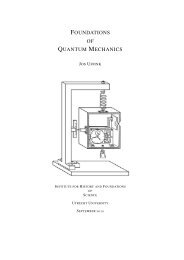Subjective probability and statistical physics
Subjective probability and statistical physics
Subjective probability and statistical physics
Create successful ePaper yourself
Turn your PDF publications into a flip-book with our unique Google optimized e-Paper software.
increases, the <strong>probability</strong> that an unknown value of P (A) is close to the given value<br />
of the relative frequency of A, say relf A n = k n<br />
, becomes arbitrarily close to one. Sometimes,<br />
the distinction between these two reading is obscured by writing the result of<br />
the theorem in the form<br />
lim P n (| k − P (A)| ≥ ɛ) = 1<br />
n−→∞ n<br />
which suggests a symmetry between the value of the relative frequency, k n<br />
<strong>and</strong> P (A).<br />
But in a more extensive notation as employed here, it should be clear that (1) is very<br />
different from<br />
∀ɛ > 0 :<br />
lim P n ({P (A) ∈ [0, 1] : |P (A) − relf A<br />
n−→∞<br />
n (η)| ≥ ɛ}) = 1 (2)<br />
Indeed, one may debate whether the theory of <strong>probability</strong> should meaningfully allow<br />
the assignment of probabilities to probabilities. Bernoulli’s work is still rather vague<br />
<strong>and</strong> uncommitted about the the domain for a <strong>probability</strong> assignment. He assigns<br />
probabilities to “events”, or to “things” or “cases”. He gives no discussion of the<br />
question whether these should be, say, outcomes of a repeatable chance set-up, states<br />
of a system, or even arbitrary propositions. In a liberal reading, one might argue that<br />
it is possible to assign a <strong>probability</strong> to anything a rational mind can be uncertain<br />
about, including perhaps propositions about an unknown <strong>probability</strong>.<br />
On the other h<strong>and</strong>, the modern formalism developed by Kolmogorov is more<br />
specific about the domain of a <strong>probability</strong> measure. Its domain is a σ-algebra A of<br />
“events”, all represented as subsets from an underlying space X. Now, this formalism<br />
is also largely indiffererent about whether these sets are thought of as representing<br />
outcomes of an experiment, states of affairs, or propositions. But it is quite clear that<br />
a proposition like “0.49 ≤ P (A) ≤ 0.51”, although perfectly meaningful, itself does<br />
not designate an event in the algebra A n over which the <strong>probability</strong> measure P n is<br />
defined, <strong>and</strong> so the formula (2) is not meaningful, let alone that it would be implied<br />
by the Law of Large Numbers.<br />
Hence, the claim that after a given number of observations of similar cases, <strong>and</strong> a<br />
given value of the relative frequency, namely 200<br />
300<br />
, we can be reasonably certain that<br />
the <strong>probability</strong> of event A (that Titius will die within a decade) is close to 2/3, as<br />
Bernoulli suggested, is a conclusion that simply cannot not be drawn from Bernoulli’s<br />
theorem.<br />
2.3 Bayes<br />
Referend Thomas Bayes, in another posthumously published work, readressed the<br />
problem left open by Bernoulli. He opened his famous Essay of 1763 as follows:<br />
Problem: Given the number of times in which an unknown event has<br />
happened <strong>and</strong> failed: Required the chance that the <strong>probability</strong> of its happening<br />
in a single trial lies between any two degrees of <strong>probability</strong> that<br />
can be named.<br />
And he elucidated:<br />
6
















